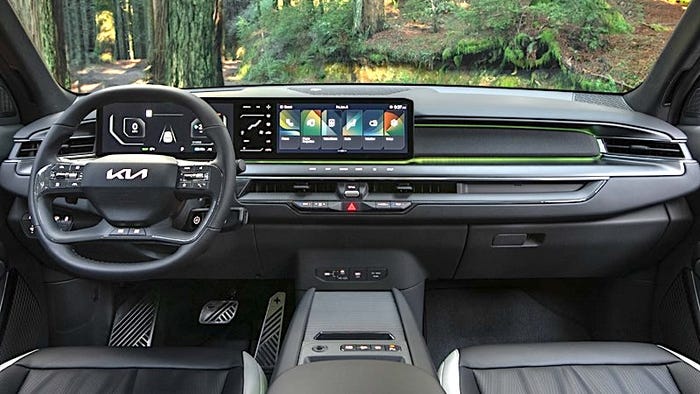Kia EV9 Targets the Family EV Sweet Spot
The ingredients for success are all here, but does the sporty GT-Line version of the EV9 deliver what families want?

At a Glance
- $56,395 starting price
- $78,430 as-tested price!
- Up to 304 miles of EV range
The Hyundai Group is leading the non-Tesla EV charge, with an aggressive rollout of vehicles built on the group’s E-GMP platform through its Hyundai, Kia, and Genesis brands and the Kia EV9 represents the Korean carmaker’s effort to stake a claim on the meat-and-potatoes three-row SUV market.
The EV9’s impressive technology, specifications, and reasonable $56,395 starting price make it a contender to help EV sales break out of the green-car niche and into the driveways of mainstream customers who are currently snapping up the brand’s very similar gas-powered Telluride as quickly as the company’s West Point, Georgia plant can produce it. The EV9 is currently manufactured in Gwangmyeong, South Korea, but production in West Point will start this summer.
The EV9 looks especially appealing when compared to the pricey, harsh-riding Rivian R1S reviewed recently. The 215-horsepower, 258-lb.-ft., rear-drive base EV9’s “Light” trim level comes with a 76.1-kilowatt-hour battery pack that is rated for 230 miles of driving range.
My preferred configuration would likely be the Light Long Range which is equipped with a 99.8 kWh battery pack that is rated for 304 miles per charge. Including the optional receiver hitch that I’d want, the total would be $61,270.
That is an admittedly borderline slow configuration, with 0-60 mph acceleration of 8.8 seconds, which is fine, but seems slow in a world of lightning-quick EVs like our top-of-the-line EV9 GT-Line. It accelerates to 60 mph in just 5.0 seconds, courtesy of its 379 hp, 516-lb.-ft. dual-motor, all-wheel-drive powertrain.
The Ocean Blue GT-Line EV9 test vehicle was gorgeous, but its $78,430 bottom line erodes the EV9’s value argument and it only goes 270 miles on the Long Range battery pack. Additionally, its 21-inch wheels look good, but they noticeably worsen the ride compared to the standard 19-inch wheels on the Light. It is still better than the Rivian R1S, but the EV9’s ride suffers because of the 21-inch wheels.
This issue is particularly obvious over sharp bumps like bridge expansion joints. Hitting those while changing lanes sends the GT-Line into a very un-GT-like wobble that is disconcerting. This problem is especially noticeable when using the EV9’s adaptive cruise control and lane-keeping assistance systems because their response to such bumps is abrupt and exacerbates the problem.
For highway driving, I stopped using these systems because they significantly worsened the driving experience. I’d have been happier with the additional tire sidewall provided by the Light’s 19-inch wheels and its longer driving range between charges.

As a family vehicle, the EV9 is light on luggage space behind the third row compared to minivans. KIA
This became an issue because I discovered the uselessness of the EV9’s included 120-volt AC portable charger, as outlined in a separate article as the result of my experience expecting to be able to add some meaningful amount of driving range by charging overnight at my mom’s house, where there is no Level 2 240-volt charger like my home ChargePoint.
I did enjoy the fact that the EV9 pretty nearly achieves its performance claims, with normal 70-mph Interstate highway and 60-mph rural two-lane driving producing almost exactly the claimed driving range. It was the same for the charging speed, which topped out at 209 kW at a 350-kW Electrify America 350-kW DC fast charger, which essentially equals the claimed 210-kW maximum charging rate.
What doesn’t meet its claimed performance is the climate control system. EV makers habitually reduce the performance of their heaters to preserve driving range in cold weather, and I found that the EV9’s temperature had to be set to 80 degrees even in not-particularly cold weather to keep the cabin comfortable. This may have been a result of generally keeping it in the Eco drive mode.

At least there is a scroll wheel to provide a physical volume control on the dashboard. KIA
This is one of the many idiosyncrasies that EV drivers will learn as we shift the vehicle fleet to EV power, as we learn to juggle factors such as battery size (and its resulting mass), wheel size (and its resulting impact on EV range and ride comfort) and other details. As the flagship trim level, the GT-Line will naturally go to a small slice of the EV9 buying public. The rest will surely be happier and better served by their lower-trim models, even if those are slightly slower and maybe don’t look quite as zoomy.
About the Author(s)
You May Also Like


.jpg?width=300&auto=webp&quality=80&disable=upscale)


